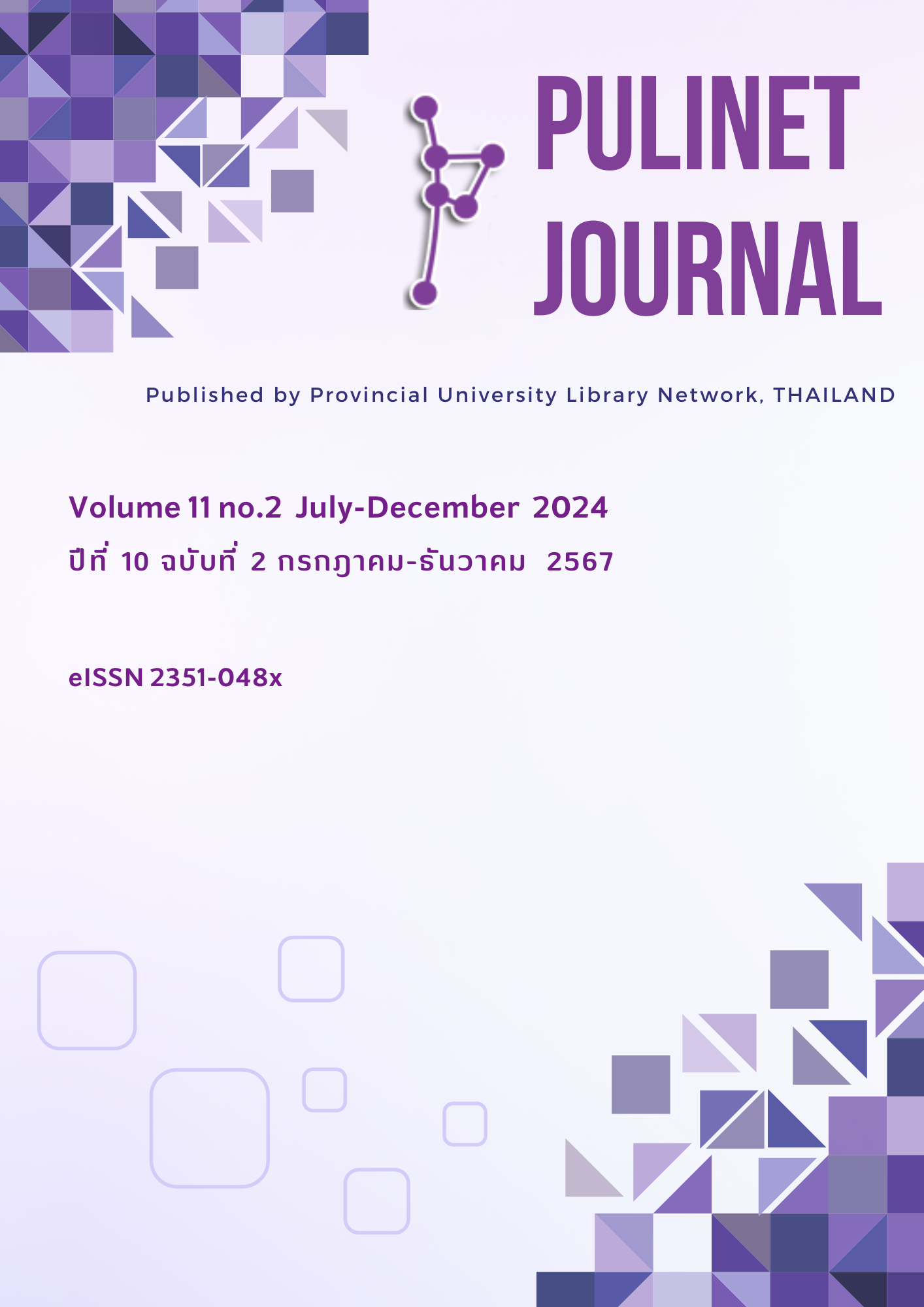การเพิ่มประสิทธิภาพการจัดเก็บและเผยแพร่ผลงานในคลังความรู้ดิจิทัล มหาวิทยาลัยเกษตรศาสตร์
Main Article Content
บทคัดย่อ
การเพิ่มประสิทธิภาพการจัดเก็บและเผยแพร่ผลงานในคลังความรู้ดิจิทัล มหาวิทยาลัยเกษตรศาสตร์ เป็นการบริหารจัดการคลังความรู้ดิจิทัล มหาวิทยาลัยเกษตรศาสตร์ โดยการพัฒนาระบบการนำเข้าข้อมูลเพื่อจัดเก็บในคลังความรู้ดิจิทัล มหาวิทยาลัยเกษตรศาสตร์เพิ่มเติมจากระบบเดิมที่มีอยู่และลดข้อจำกัดในการนำเข้าข้อมูล อำนวยความสะดวกให้กับเจ้าของผลงานในการนำเข้าข้อมูลด้วยตนเองได้อย่างรวดเร็ว ทุกที่และทุกเวลาตามต้องการ
ระบบบันทึกผลงานสร้างสรรค์ มหาวิทยาลัยเกษตรศาสตร์ (KUKR Input) พัฒนาโดยการรวบรวมปัญหา อุปสรรค ที่พบจากระบบนำเข้าข้อมูลคลังความรู้ดิจิทัล มหาวิทยาลัยเกษตรศาสตร์ (KUKR Data Entry) และข้อเสนอแนะที่ได้รับจากผู้บันทึกของส่วนงาน และเจ้าของผลงานจากการฝึกอบรม กิจกรรมส่งเสริม Roadshow ต่าง ๆ และวางแผนการดำเนินงานตามข้อสรุปที่ได้จากการประชุม มีการดำเนินงานพัฒนาระบบผลงานสร้างสรรค์ มีการทดสอบความพร้อมของระบบก่อนเปิดใช้งานจริง มีการจัดฝึกอบรมการใช้ระบบ พร้อมกับการส่งเสริมประชาสัมพันธ์ผ่านทางสื่อสังคมออนไลน์ เช่น Facebook และ Line คลังความรู้ดิจิทัล มหาวิทยาลัยเกษตรศาสตร์ และเว็บไซต์ของสำนักหอสมุดและมหาวิทยาลัยเกษตรศาสตร์ จากนั้นจึงมีการรวบรวมและรายงานปัญหาของการใช้งานระบบเพื่อร่วมแก้ไขปัญหาและปรับปรุงระบบ มีการประเมินผลความพึงพอใจการใช้งานระบบจากผู้ใช้งานจริง และนำมาสรุปผลการดำเนินงานและปัญหาการใช้ระบบ เพื่อพัฒนาปรับปรุงประสิทธิภาพของระบบและตรงกับความต้องการของผู้ใช้ให้มากขึ้น
ผลการดำเนินงานพัฒนาระบบบันทึกผลงานสร้างสรรค์ (KUKR Input) เมื่อเปรียบเทียบกับระบบนำเข้าข้อมูลของส่วนงาน KUKR Data Entry พบว่า กระบวนการในการนำเข้าข้อมูลจนถึงเผยแพร่ข้อมูลลดลงจาก 11 ขั้นตอน เหลือ 6 ขั้นตอน และลดข้อจำกัดของระบบเดิมที่ให้เฉพาะผู้บันทึกของส่วนงานที่ได้รับมอบหมายเป็นผู้นำเข้าข้อมูลเท่านั้น โดยเพิ่มช่องทางให้เจ้าของผลงานสามารถนำเข้าข้อมูลด้วยตนเอง อัปโหลดไฟล์เอกสารผลงาน กำหนดสิทธิ์ในการเผยแพร่ผลงานได้ทุกเวลา และช่วยลดระยะเวลาในการบันทึกและเผยแพร่ให้บริการข้อมูลในคลังความรู้ดิจิทัลได้เร็วขึ้น ซึ่งมีผู้ใช้งานระบบบันทึกผลงานจำนวน 173 คน และมีผลงานที่บันทึกเข้าระบบจำนวน 515 รายการ เมื่อประเมินความพึงพอใจของระบบบันทึก โดยภาพรวมมีค่าเฉลี่ยความพึงพอใจอยู่ที่ 4.58 อยู่ในเกณฑ์ระดับดีมาก และส่วนเบี่ยงเบนมาตรฐานเท่ากับ 0.58
Article Details

อนุญาตภายใต้เงื่อนไข Creative Commons Attribution-NonCommercial-NoDerivatives 4.0 International License.
เอกสารอ้างอิง
จุฑามาศ ถึงนาค, นพดล เอกผาชัยสวัสดิ์, สุนิศา รอดจินดา และดารารัตน์ จุฬาพันธุ์. (2562). การพัฒนาและการจัดการคลังปัญญาดิจิทัล มหาวิทยาลัยศิลปากร. Veridian E-Journal, Silpakorn University (Humanities, Social Sciences and arts), 12(1), 603-619. https://he02.tci-thaijo.org/index.php/Veridian-E-Journal
ปริญญา น้อยดอนไพร. (2566). คลังความรู้สถาบันคืออะไร (IR: INSTITUTIONAL REPOSITORY). https://arit.sru.ac.th/th/news-activities/arit-share/750-institutional-repository.html
สุราภรณ์ คงผล และอารีย์ ธัญกิจจานุกิจ. (2562). แนวทางการจัดการความรู้เพื่อพัฒนาคลังความรู้ดิจิทัล มหาวิทยาลัยเกษตรศาสตร์. ใน เอกสารการบรรยายการประชุมวิชาการระดับชาติ PULINET ครั้งที่ 9 (หน้า (2-487)-(2-496)). สำนักหอสมุด มหาวิทยาลัยบูรพา.
อารีย์ ธัญกิจจานุกิจ, นัดดาวดี ชาญอนงค์สุข, วันทนี โกวิทางกูร, นภา เชี่ยวชูวงศ์, วราภรณ์ แดงช่วง, สารภี สีสุข และศศินพร นาคเกษม. (2548). การใช้ฐานข้อมูลออนไลน์ของอาจารย์ นักวิจัย และนิสิตบัณฑิตศึกษา มหาวิทยาลัยเกษตรศาสตร์ วิทยาเขตบางเขน: รายงานผลการวิจัย. มหาวิทยาลัยเกษตรศาสตร์ สำนักหอสมุด.
อารีย์ ธัญกิจจานุกิจ. (2549ก). การพัฒนาฐานข้อมูลภูมิปัญญา มหาวิทยาลัยเกษตรศาสตร์. มหาวิทยาลัยเกษตรศาสตร์ สำนักหอสมุด.
อารีย์ ธัญกิจจานุกิจ. (2549ข). รวมผลการศึกษาและการสำรวจข้อมูลเพื่อการพัฒนาระบบสารสนเทศด้านการเกษตร. มหาวิทยาลัยเกษตรศาสตร์ สำนักหอสมุด.


